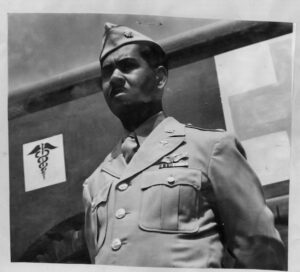The policies of the armed services in World War II reflected the stresses and contradictions of segregated American society of the time, and historical records show the Army Air Forces and its medical service were no exception. As the United States observes Black History month, it is worth reflecting on the exceptional contributions of our Black military and civilian personnel, the value of a diverse force, and the lasting impact people can have regardless of race and the barriers they may have to overcome.
Despite the administrative costs and inefficiencies of segregation, and facing a war on multiple fronts, the armed services did not move to integrate the hundreds of thousands of African Americans who enlisted for wartime service. Army Air Forces leaders mistakenly assumed that segregation would lessen racial tension and morale problems by limiting contact between African American and white troops. Additionally, this complicated routine matters such as replacement assignments by creating a requirement for an essentially duplicate personnel system in which neither white nor African American Airmen could necessarily be substituted for each other.
In 1940, at the eve of war, only a few African American doctors were serving as officers in the Reserve Corps of the Army Medical Department. By 1941, the War Department began training military flyers at Tuskegee, Alabama – activating the first African American flying units in the history of the United States.
This created new requirements at Tuskegee Army Airfield with the activation of an African American station hospital including medical support personnel. In early 1941, the first African American physician, Capt. Maurice E. Johnson, arrived.
It was also necessary to build a cadre of flight surgeons and medical technicians who could serve with the flying squadrons. But in 1941, no African American physicians had yet trained to become flight surgeons.
One reserve officer determined to answer the call for active duty service upon the start of the war was Vance H. Marchbanks, Jr. Despite being turned away on the basis of limited training facilities for African American officers, he persisted and received the rank of first lieutenant in the Medical Corps by April 1941.
The following spring, Marchbanks transferred to Tuskegee Army Air Forces Flying School and completed the School of Aviation Medicine extension course in December 1942.
His tenacity however, highlighted a larger problem. The training of African American flight surgeons was entirely by correspondence course rather than in residence at the School of Aviation Medicine at Randolph Field.
This changed in February 1943 when the School of Aviation Medicine accepted two physicians assigned to Tuskegee for its residence program, Harold E. Thornell and Bascom S. Waugh. They were integrated into the classes, mess, and quarters with the white students. While only involving a handful of officers, the event provided a lesson that contradicted segregationists’ concerns.
The school commandant, Brig. Gen. Eugen G. Reinartz, recalled that African American students performed well alongside their fellow classmates, and emphasized that there was no difficulty integrating the classes.
In the spring of 1943, the 99th Fighter Squadron, the first African American flying unit, deployed, accompanied by Johnson as a flight surgeon. The squadron participated in operations throughout North Africa and Italy until June 1944 when three more fighter squadrons of Tuskegee Airmen joined and became part of the 332nd Fighter Group. They supported the American strategic bombing campaign that lasted through the end of the war in Europe.
Marchbanks, now a major, served as group surgeon presiding over an aid station capable of addressing routine health-related cases in military quarters, and emergency medical and surgical treatment.
The 332nd Fighter Group’s medical personnel handled both typical flying and battle injuries such as gunshots, burns, frostbite, and fractures, as well as preventive medicine, base sanitation, and psychological issues.
The fliers of the 99th Fighter Squadron had been in combat for over a year and several benefited from receiving psychotherapy treatment, successfully returning them to the fight.
After the war, President Harry Truman issued Executive Order 9881 to abolish discrimination “on the basis of race, color, religion and natural origin.” On that day, July 26, 1948, began the process of desegregation throughout the armed services.
Undoubtedly, the service of the Tuskegee Airmen influenced the progression toward desegregation and the Air Force, which had recently separated from the Army in 1947, was particularly vocal.
“It is the feeling of this headquarters that the ultimate Air Force objective must be to eliminate segregation among its personnel by the unrestricted use of Negro personnel in free competition for any duty within the Air Force for which they qualify,” Chief of Staff of the Air Force, Gen. Carl Spaatz said.
Even as an independent Air Force Medical Service stood up on July 1, 1949 – segregated units were standing down. By the end of 1950, roughly 95% of the African Americans in the Air Force were in integrated units.
Marchbanks himself would eventually retire as a colonel in 1964 with a particular highlight in his career supporting NASA as an aeromedical monitor for John Glenn’s 1962 Project Mercury orbit of the earth. Even after retirement, Marchbanks remained involved in aeromedical research with findings that exhibited that carriers of sickle cell trait need not be disqualified from flight training.
